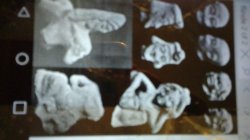Dan Hopkins
New Member
Buddha in Mephis Egypt 500 B.C.
"The British School of Archaeology in Egypt has begun its great work on Memphis by excavations this spring. The foreign quarter has been found around the temple of King Proteus described by Herodotus, who proves to have been Merenptah of the XIXth dynasty. And all over the foreign quarter are found small heads modeled in pottery, which clearly are copied from various races which were welded together by the Persians, and who all met in the foreign settlement in Memphis. Those here shown are some of the most important types. First is the Sumerian or Accadian, the old Turanian people who started civilization in Babylonia. Their heads are identified by closely similar portraits carved in stone about 3,000 B.C. and found in Mesopotamia. Below that is the Persian great king, with a long profile of a high type, identified by the tiara, disc, and bushy hair. At the bottom is the Scythian horseman, the Cossack cavalry of the Persian army, as known to us with his pointed hood and bushy beard on the Crimean vases. On the right side, at the top, is the Tibetan Mongolian, below that the Aryan women of the Punjab, and at the base a seated figure in Indian attitude with the scarf over the left shoulder. These are the first remains of Indians known on the Mediterranean. Hitherto there have been no material evidences for the connection which is stated to have existed, both by embassies from Egypt and Syria to India, and by the great Buddhist mission sent by Asoka as far west as Greece and Cyrene. We seem now to have touched the Indian colony in Memphis, and we may hope for more light on that connection which seems to have been so momentous for Western thought." W. M. Flinders Petrie, Man, Volumes 7-8, p. 129
"The British School of Archaeology in Egypt has begun its great work on Memphis by excavations this spring. The foreign quarter has been found around the temple of King Proteus described by Herodotus, who proves to have been Merenptah of the XIXth dynasty. And all over the foreign quarter are found small heads modeled in pottery, which clearly are copied from various races which were welded together by the Persians, and who all met in the foreign settlement in Memphis. Those here shown are some of the most important types. First is the Sumerian or Accadian, the old Turanian people who started civilization in Babylonia. Their heads are identified by closely similar portraits carved in stone about 3,000 B.C. and found in Mesopotamia. Below that is the Persian great king, with a long profile of a high type, identified by the tiara, disc, and bushy hair. At the bottom is the Scythian horseman, the Cossack cavalry of the Persian army, as known to us with his pointed hood and bushy beard on the Crimean vases. On the right side, at the top, is the Tibetan Mongolian, below that the Aryan women of the Punjab, and at the base a seated figure in Indian attitude with the scarf over the left shoulder. These are the first remains of Indians known on the Mediterranean. Hitherto there have been no material evidences for the connection which is stated to have existed, both by embassies from Egypt and Syria to India, and by the great Buddhist mission sent by Asoka as far west as Greece and Cyrene. We seem now to have touched the Indian colony in Memphis, and we may hope for more light on that connection which seems to have been so momentous for Western thought." W. M. Flinders Petrie, Man, Volumes 7-8, p. 129

